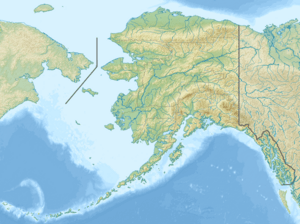Casadepaga River facts for kids
Quick facts for kids Casadepaga River |
|
|---|---|
|
Location of the mouth of the Casadepaga River in Alaska
|
|
| Country | United States |
| State | Alaska |
| District | Nome Census Area |
| Physical characteristics | |
| Main source | Seward Peninsula 1,662 ft (507 m) 64°49′30″N 164°39′12″W / 64.82500°N 164.65333°W |
| River mouth | Niukluk River 31 miles (50 km) northeast of Solomon 164 ft (50 m) 64°58′12″N 164°04′30″W / 64.97000°N 164.07500°W |
| Length | 32 mi (51 km) |
The Casadepaga River is a waterway in Alaska, near the city of Nome. It is also known by its older names, Koshotok and Koksuktapaga. This river is about 30 miles (48 km) long. It flows generally towards the northeast. It is the biggest southern branch of the Niukluk River.
Contents
Exploring the Casadepaga River's Geography
The Casadepaga River flows through a wide valley. This valley is cut into higher land that ranges from 800 feet (240 m) to 1,800 feet (550 m) high. The river itself doesn't drop very steeply. For every mile it flows, it drops only about 13 feet (4.0 m) to 14 feet (4.3 m). From its mouth to near its source, the total drop is about 400 feet (120 m).
The area around the river collects a lot of water. This means the river is large enough for small boats and canoes. You can travel about 15 miles (24 km) (24 km) by boat on the river. The ground beneath the river basin is made of limestone and schist rock. These rocks often have veins of quartz, which is a type of mineral. Some of these quartz veins contain gold.
The river's valley is filled with deep layers of gravel. The river has cut its way through this gravel. In some places, the riverbed is 30 feet (9.1 m) to 150 feet (46 m) deep. This cutting has left behind flat areas called gravel terraces or benches along the riverbanks. Closer to the river's source, the gravel sits on top of wide, rock-cut ledges.
Gold Discoveries Along the River
Many smaller streams, called gulches, join the Casadepaga River. One of these is Dawson Gulch. It joins the river near Big Four Creek. Big Four Creek was named after the first four people who searched for gold there. In this area, gold was found in the bedrock, which is the solid rock beneath the soil. This gold was often found with a mineral called garnet.
There are also several gulches on the east side of the river, between Big Four Creek and Dixon Creek. Mount Dixon, north of Dixon Creek, has a cap of strong, gray limestone. Below this limestone, there is mica schist, which contains small quartz veins. Dry Gulch is another small channel. The gold found in Dry Gulch was not on the bedrock. Instead, it was found in the gravels of the terraces, often on layers of clay.
The Casadepaga River's History
The Casadepaga River has had a few different names over time. On an early map from 1899, it was called Koshotok. A map from 1900 called it Koksuktapaga. Later, the United States Board on Geographic Names changed the name to Casadepaga. This name is thought to come from a local language. Some people believe it means "the river with a loon at its mouth."
Early Gold Prospecting
The first people to search for gold along the Casadepaga River were Daniel B. Libby, A.P. Mordaunt, L.S. Melsing, and Harry L. Blake. They explored the area in 1898. These four pioneers were known as the "Big Four." That's why the largest stream flowing into the Casadepaga is called Big Four Creek.
In 1898, people started claiming land for gold mining as far up as Goose Creek and Quartz Creek. However, most of the land claims on the river and its smaller streams happened in 1899. In 1899, Quartz, Boulder, Dixon, and Spruce creeks produced thousands of dollars worth of gold. This gold was found during exploration, not from large-scale mining.
In 1900, there were delays for miners getting into the area. Later, low water levels made it hard to transport supplies. In the fall, floods washed away many dams and sluice boxes, which are tools used for mining. Because of these challenges, 1900 was mostly a year for more exploration, not much mining.
Connecting to the World
A big change for the Casadepaga area was the extension of the Council City and Solomon River Railroad. This railway reached Penelope Creek, which is a tributary of the Casadepaga. This train line made it much easier to connect the mining district with ocean transportation routes. By 1906, most of the work along the Casadepaga River was done by individual prospectors, not large mining companies.
Tributaries of the Casadepaga River
The Casadepaga River has many smaller streams, called tributaries, that flow into it.
- Near Bonanza Creek, mining camps were set up. They worked to find gold in the low gravel banks of the Casadepaga.
- From Bonanza Creek to Penelope Creek, people used drills to explore the river gravels during the summer.
- Big Four Creek is a tributary that joins the Casadepaga from the south. In 1906, only basic assessment work was done there.
- Birch Creek flows into Big Four Creek. About 5 miles (8.0 km) upstream from the Casadepaga, two camps were working to find gold in the creek gravels below Shea Creek.
- Dixon Creek is about 2 miles (3.2 km) upstream from Big Four Creek on the Casadepaga. The bedrock here is made of schist and limestone.
- Penelope Creek became the end point of the Council City and Solomon River Railroad. This railway connected Penelope Creek to Solomon, about 32 miles (51 km) away.
- About three-quarters of a mile above Goose Creek, there is a wide area of gravels.


